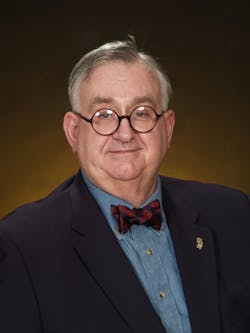Command Post: Going for the Gold: Organizational Structure
In this visit with you, I intend to continue my coverage of the basic elements of organizational structure. You cannot imagine how many times I have found that certain people never seem to do well in an organizational setting. It has been my experience that they usually fail simply because they have no idea of how an organization works. So in this article, let’s consider how an organization is structured and what that means for your department.
Job definition
It is important to note that fire service folks are no different from any other sort of people. They have to work within an organizational context. Whether you are building airplanes, sweeping streets or fighting fires, the basic concepts are the same. As I pointed out in an earlier column, an organization is structured according to a series of basic relationships. The first is job definition.
Job definition calls for the breakdown of work into the parts that are considered necessary for its completion and for the determination and definition of the bounds of each part. We do this in the fire service when we break our fire department down into such functions as engine and truck companies, fire prevention and public education planning, service and staff functions.
Each task that contributes to the mission of your fire department has to be identified. You must look at them all to be sure that you are not missing anything that might detract from the effectiveness of your organization. Many fire departments set themselves up for failure when they limit themselves to the standard firefighting duties. They do this to the exclusion of such important areas as code enforcement and public education.
Group the functions
Once an organization has determined all of the tasks that it feels it must undertake to properly protect its citizens, it then can take the next structural step in developing its organization. It will develop a form of departmentalization to get the various jobs done. This would be the point at which like functions or areas of concern are grouped together. You will find many examples of this in larger fire departments. All training functions are placed in the training division, all firefighting operations in the suppression division, and the ancillary functions into a services division.
This type of specialization allows you to develop skill and knowledge groups around the various areas of expertise. Hopefully, as people gain knowledge and experience in these areas of departmentalization, service delivery will improve.
But what about other fire departments, such as smaller career departments or volunteer or combination agencies? Even in these you must develop experts within your department who are sharp enough to perform extra duties, in addition to their basic firefighting roles. People have to double in brass, as the old Circus Bands once found out.
For a great many years, my work as a volunteer firefighter encompassed the roles of fire officer, fire chief, line firefighter, driver, public relations person and training officer. That’s just the way it was. There were lots of jobs to do, and I took on the ones for which I was best suited.
I can recall that period of time just after I left the fire chief's position in my volunteer fire department how I once again took up my old multiple roles. You folks in the smaller department must also learn to double in brass if you are to accomplish the many aspects of your important community role.
Supervisory roles
A critical activity in any organization is the supervision of people. It is in this area that the next concept, span of control, gains importance. This has to do with how many people can effectively be controlled by a single supervisor. While a great many different schools of thought about ratios have been preached by our fire service management gurus, it has been my experience that you must tailor the supervisory environment to your organization.
The task to be supervised plays a very great part in how many personnel can be controlled by a single supervisor. In a highly complex and technical environment, where instructions much be relayed continually and back and forth interplay occurs frequently, you will find less people reporting to a given boss. In an area of highly repetitive manual skills, a great many people can be handled by a single person.
In the fire service, you will generally find a ratio of five or six subordinates reporting to a single supervisor. However, do not allow yourself to be hamstrung by tradition or the dictates of outsiders. Experiment and see what works best for you.
Delegation of authority
The last of the structural components you must work to understand and implement is the delegation of authority. The boss cannot make all of the decisions in any organization, small or large.
In those cases where this is true, the organization can literally come to a standstill waiting for a decision. During my career, it has been my unfortunate experience to have been exposed to organizations where even the smallest detail of company operations had to be passed along up to the chief of department for review and decision. The results have been devastating to both morale and performance.
In a truly effective organization, people are trained to think. They are then equipped to perform their work and are allowed to make those operational decisions that fall under their level of the organization. They have not been held hostage to the mind of the boss.
Each supervisor is made fully aware of the parameters of a good decision. Then each supervisor is given an area of operations wherein he or she can supervise, decide and do their job. They are totally responsible for their working subdivision of the organization as a whole. This can and should be done within the fire department framework.
Because a fire department falls under the “scalar principle,” we follow an established chain of command. Each person knows who they will receive their orders from and to whom they will report. It is the wise organization that makes sure that the chain of command works on a two-way basis.
Far too many times we see great quantities of downward communication, with precious little tolerance for the information that might wish to flow upward. Guard against this tendency to freeze the lower levels of your organization out of your program.
It is very important for you as a member of an organization to know exactly what type of organization you belong to. The extremes of style run from the highly centralized type, with all decisions made by a single person, or a very small and highly selective group of trusted henchmen, on out to a highly decentralized style, with decisions made at the lowest responsible level possible. Decisions are best made, I feel, closest to their source.
Reflect on your organization
You should be able to tell fairly quickly whether you are in an organization that will cheerfully encourage your full and effective participation. You should be able to uncover the opposite with equal ease. It should be recognized that the more highly centralized an organization is, the greater will be its tendency to take away personal freedoms and stifle individual creativity. It is my hope that you will take the knowledge that has been delivered in this column and make it a part of your mental data bank, so that you can develop your skills as an organizational leader and member.
About the Author

Dr. Harry Carter
HARRY R. CARTER, Ph.D., who is a Firehouse contributing editor, is a fire protection consultant based in Adelphia, NJ. He is chairman of the Board of Commissioners in Howell Township Fire District 2 and retired from the Newark, NJ, Fire Department as a battalion commander. Carter has been a member of the Adelphia Fire Company since 1971, serving as chief in 1991. He is a life member and past president of the International Society of Fire Service Instructors and life member of the NFPA. He is the immediate past president of the U.S. branch of the Institution of Fire Engineers (IFE) of Great Britain. Carter holds a Ph.D. in organization and management from Capella University in Minneapolis, MN.
Connect with Harry:
Email: [email protected]
